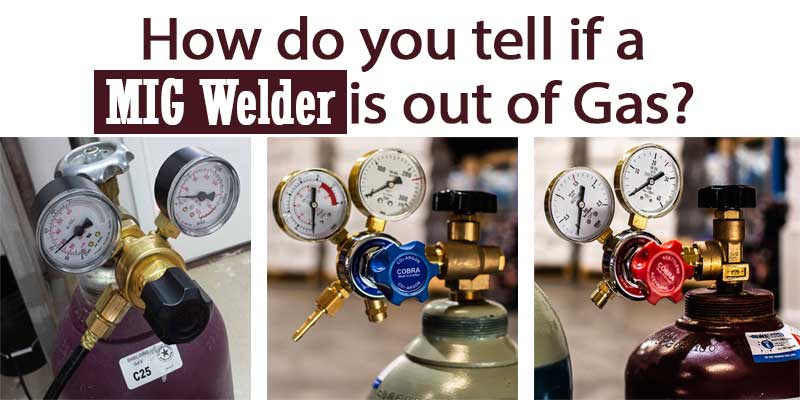MIG welders require a full tank of shielding gas to complete the weld. Shielding gas helps a MIG welder to make contact with the welded materials without other particles. Also, contaminants in the air can’t impact the weld due to the inert gas. Continuing a welding process is not possible when you run out of gas. Now, how do you tell if a MIG welder is out of gas?
Every MIG welding tank has gauges measuring flow and pressure to determine the gas level of the tank. If the indicator reaches a low level, a refill or replacement of the gas tank is required. Otherwise, future MIG welds will not get the necessary pressure and strength.
This comprehensive guide explores the symptoms if a MIG welder is out of gas.
How do You Tell if a MIG Welder is out of Gas?
Table of Contents
You will notice the welding pool’s remarkable inconsistency due to the gas’s low level. The reason is gas protects the weld from multiple environmental impurities.
The below points will help you know your MIG weld tank has a low gas level,
- Weld puddle has air bubbles
- Joints consist of visible spatter
- Weld has holes
- Excessive sparking or smoking during the welding process
Due to the low gas level, you will experience several flaws in the joint.
Additionally, there are 4 different methods available to determine the low gas level. The methods are discussed below.
Method 01: Gauge Checking
As stated earlier, every MIG welding tank comes with regular pressure gauges. Reading these gauges will give you an estimation of whether the gas tank is close to empty.
If the gauge is close to zero, it might indicate that the tank is almost out of gas, and replacement or refill is required.
Method 02: Weighing the Gas Tank
This method applies if you know the weight of a full and empty tank. The difference between them will assist you in knowing when the gas tank is empty.
So, it would always be best to weigh your MIG welder gas tank when it is full.
Method 03: Hot Water Test
The hot water test is relatively easy and quick to get an idea of the gas level in the tank. For this, follow the below steps.
Step 01: Take a bowl of boiling water.
Step 02: Pour the boiled water outside the MIG welding gas tank.
Step 03: After a few minutes, put your hands on the outside of the tank and feel the temperature. You will surely feel the temperature difference between the empty and gas-filled portions. The larger portion of your tank is generally the empty part.
Note: This method is exceptionally workable for argon tanks.
Method 04: Notes from Last Time
Always keep notes of the time of gas use and the gas level.
When the gas level starts to reduce, a noticeable change happens in the welding pool’s consistency.
By taking note of the last time on-time refilling or replacement. Thus, you will never experience a low gas level. At the same time, your welding accuracy and productivity will be retained.
Why Should You Keep Track of Your Welding Tank Gas Level?
A low gas level means the welding puddle is improperly shielded. When it happens, welding results could face contamination. Finally, the weld quality and strength get poorly hampered.
You will see the below things in the weld when you are out of gas,
- Air bubbles
- Holes
- Spatter
- Lots of smoke
- More sparking
The absence of gas will significantly affect the weld quality. The impurities in the air will interact with the puddle and can create holes and air bubbles in the work.
Spatter is another problem that can happen while welding. More dangerously, you may find holes in the welded materials.
In addition, since the weld will react with the air more than before, excessive sparkles or smoke will be created too.
Any of the above incidents will badly reduce the quality of the weld. Moreover, your productivity and accuracy will be hampered. When you experience the above issues, don’t be late to turn the welder off and inspect the gauges.
The gauges will indeed indicate that you are running out of gas, and a refill or replacement is a must. Once refilled, these signs will go away, and you can begin welding.
How to Refill an Empty MIG Welding Gas Tank?
While refilling an empty MIG welding gas tank, safety is the most important thing. To ensure safety, bring the gas tank to a welding supply and let them refill it for you.
The welding supply will give you a new tank and keep the empty one.
To keep yourself always having the gas, buy multiple tanks. Thus, you will never go out of gas and have a backup tank to meet your welding requirements.
Now, gas cylinder storage is the key to ensuring safety. So, taking safety precautions is mandatory. Keep the below considerations in your mind,
- Store the gas cylinder out of direct sunlight or heat
- Store the tank in an upright position
- Protective caps must be installed on the valve
- Keep the gas tank away from severe elements like corrosion, ice, snow, water, etc.
- Ensure that the storage area is well-ventilated
All the above factors will keep your MIG welding gas tank safe and well-protected. Also, don’t forget to return the empty gas tank to the welding supplier.
Last Notes
MIG welding is popular among beginners and professionals because it is easy to learn and use. This cost-efficient welding process can help you save precious money.
But a MIG welder performs best when the gas tank is 100% filled. Lack of gas will minimize the weld quality greatly. Moreover, the joints become less durable and strong when the welding gas tank has a low gas level.
Hopefully, after reading this guide on how do you tell if a MIG welder is out of gas, you can ensure good weld quality every time.

